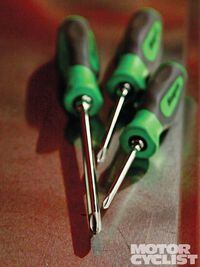Modern bikes don’t have many Phillips-head fasteners on them—at least not as many as back in the day. When used properly, the Phillips head lets the driver slip out before too much torque can be applied. This makes Phillips fasteners an especially good choice for low-torque applications like the engine covers on ‘70s-vintage Japanese bikes, for example. Though the specified torque may be light, decades of repeated heating and cooling cycles plus corrosion created by steel mating to aluminum can make removing aged Phillips screws a real pain. Oddly enough, the cheesy Phillips shank found in most vintage Japanese bike tool kits works especially well on these old case screws. Small carburetor screws and the tiny ones holding brake reservoir lids in place seem especially prone to stripping. To prevent stripping, invest in a selection of quality Phillips screwdrivers—this is not where you want to economize. Get a quality tool in the common #1, #2 and #3 sizes used on motorcycles. If you see that there is a small dimple or punch mark on the screw head, you are dealing with a Japanese Industrial Standard (JIS) fastener. For best results here you should use a JIS-spec screwdriver, but these can be difficult to find in the U.S. If you are a dedicated tool guy or you work on a lot of vintage Japanese bikes, make the extra effort to search the Internet for JIS screwdrivers. Always make sure that the tip fits the fastener snugly, and the tool still has sharp edges to securely engage the fastener, and even the most stubborn screws should back right out.
Latest

/cloudfront-us-east-1.images.arcpublishing.com/octane/D2BDYKKNZ5GRHGDMI4PZTGRMME.jpg)

/cloudfront-us-east-1.images.arcpublishing.com/octane/UAY4WSZPOFDQRP4MCEXAKDFQOQ.jpg)

/cloudfront-us-east-1.images.arcpublishing.com/octane/X5CE3KSJHZHM5CUFGPZ7U26WB4.jpg)
/cloudfront-us-east-1.images.arcpublishing.com/octane/COWLTPGFAFGDDGJCTENYMA4VJM.jpg)
/cloudfront-us-east-1.images.arcpublishing.com/octane/H3PKUGPSUJFTND4RFPSI4OIDCE.jpg)
/cloudfront-us-east-1.images.arcpublishing.com/octane/UHGQA3MQDFCA3HLBWF7S76WH6Y.jpg)
/cloudfront-us-east-1.images.arcpublishing.com/octane/Q5EORCSTNFAVBJC4IYUHIKJTXQ.jpg)
/cloudfront-us-east-1.images.arcpublishing.com/octane/XIJ5FUFSP5A3NL7MOVZGJXAHC4.jpg)
/cloudfront-us-east-1.images.arcpublishing.com/octane/V5NZN3CGS5B5PPYFYJHIPAU5S4.jpg)
/cloudfront-us-east-1.images.arcpublishing.com/octane/CZE6ONOBU5E7HPIEEADU376C4M.jpg)
/cloudfront-us-east-1.images.arcpublishing.com/octane/UT4KL3SIYJBSPNHWJXTBE6MTGE.jpg)
/cloudfront-us-east-1.images.arcpublishing.com/octane/Q3UOIDZ22ZEVDBZUWGJXIMGJKI.jpg)
/cloudfront-us-east-1.images.arcpublishing.com/octane/YQM66WXZV5AAXNNOIUVOGVXZMY.jpg)
/cloudfront-us-east-1.images.arcpublishing.com/octane/J47NFTXNLFFGHELHZCUD2LCITA.jpg)
/cloudfront-us-east-1.images.arcpublishing.com/octane/NXPQBTLX3NCILKQ2GCFJYNIDEM.jpg)
/cloudfront-us-east-1.images.arcpublishing.com/octane/6U7NJLAYMRBZTIGNKWIA5OK2FQ.jpg)
/cloudfront-us-east-1.images.arcpublishing.com/octane/IYTZQWUROVC25IMTDEWUDQ5IQE.jpg)
/cloudfront-us-east-1.images.arcpublishing.com/octane/YJODDXEL2ZB5TENKPPN4BEYJAE.jpg)
/cloudfront-us-east-1.images.arcpublishing.com/octane/QEQQUZYNJFAIJB4DZFVFSNTCQ4.jpg)
/cloudfront-us-east-1.images.arcpublishing.com/octane/F4EEHDT3UZFKPLKVGDWMMPFEQE.jpg)
/cloudfront-us-east-1.images.arcpublishing.com/octane/J47U6OWNLBFBBG75A3ILAKFYZU.jpg)
/cloudfront-us-east-1.images.arcpublishing.com/octane/XWWQYTL3J5B7LKXDI354FFF4NQ.jpg)